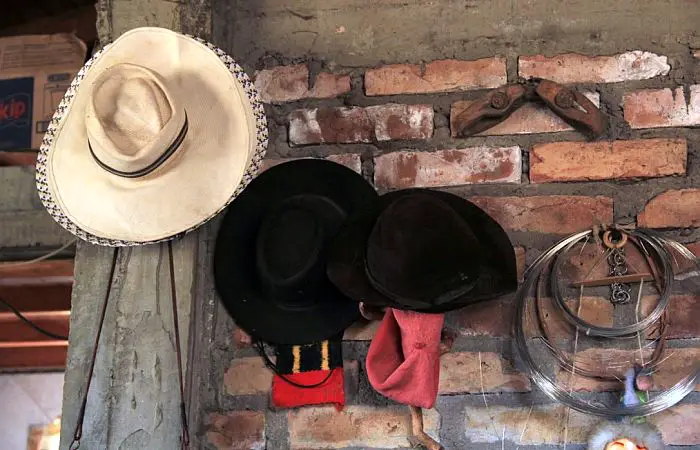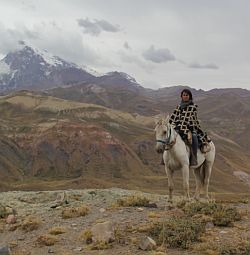The Argentinian Gaucho Horse Whisperer of Cordoba
Story and photos by Madelaine Triebe
In a change from the Argentine gaucho tradition of dominance by force to break a horse, a writer watches a horse whisperer establish trust through hours of interaction.

"The most important thing is to respect the horse and to always remain with the same calm energy no matter what happens. Never change the calm safe energy," he says with his thumb and index finger pressed together drawing a straight line from the chest. Always be centered," Diego tells me, pointing at his heart and center of his chest to show where his energy comes from as he is working with the Peruvian Paso horse in the corral.
With the backdrop of the Sierras Chicas in Cordoba—a province in the middle of Argentina famous for its green rolling hills—I am watching Diego Dangelo, the horse trainer working with the beautiful chestnut horse who has been deemed indominable—unbreakable in Spanish—by everyone who has encountered it before. It's a hot afternoon at about 30 degrees Celsius and the horse in the corral is called Artiro. The horse has trust issues and has never been ridden. He doesn't want any contact with humans, let alone a person on his back. As you approach him, he walks the opposite direction; no one can get close to him.
Except for Diego.

The Dark Side of Argentine Gauchos and Their Horses
None of us, including Diego and Artiro's current owner, know much about the life history of the horse. But Diego is certain that its complete lack of trust in humans is because the horse previously has been mistreated and beaten.
The travel publications and Argentine news outlets love to publish images of Martin Tatta and Scarpati, men referred to as horse whisperers who display very gentle ways of working and interacting with horses. In truth, these indeed have become more popular ways of training horses in Argentina. In reality though, the country has a long history of much harsher ways of handling horses, with lots of machismo in the mix. Meaning male chauvinism in Spanish, the Argentine horse world is no exemption to masculine dominance and force.
"The old way of breaking a horse in Argentina was to tie it to a tree and leave it for 24 hours without any food or water. Then you would come back, and the horse would either be dead because it got caught in the lead rope trying to break free or would be completely submissive because of hunger and fatigue." That was the description from Kevin, the owner of Estancia Los Potreros, an estancia (ranch) just outside Rio Ceballos, a 30-minute drive from Unquillo, where I am watching Diego patiently wait for Artiro to get into the corral. At the estancia the gauchos have adapted some of the natural horsemanship techniques introduced by the previous horse trainer.
Further away in Jesus Maria, a small town an hour's drive north of Cordoba, gauchos compete in the province of Cordoba's very own annual rodeo festival. The classic photo from the festival is a rearing horse with a gaucho with a black hat, shirt, and a neck scarf tied around his neck sitting on a criollo horse with spurs pressed into the horse to trigger it to stand on its back legs. Or a bucking horse and a gaucho with leather boots and spurs and a raised arm with a rebenque in his hand hitting the horse and trying to stay on at the same time.
In both cases, the gaucho that stays on the longest wins.

Since my first visit to Argentina, back in 2011, I have had my fair share of experiences and stories about various gaucho traditions. I have ridden in the mountains with gauchos, immersed myself in their traditions and been on numerous horse rides in Argentina. As much as I have been baffled and impressed by their riding skills—maneuvering horses doing cattle work on steep rocky hills and effortlessly riding any type of horse—I have also witnessed moments of excessive force being used on horses.
I have watched a gaucho throw a 3-kilo rock on a mule in the Andes when it didn't want to go the way he did and I have watched men excessively beat horses with the rebenques —the cowhide flat whip normally used by gauchos for cattle work—to get the horse to do what they want.
Soft Persuasion and Gentle Movements
Watching Diego work with horses is a very different story. He never uses a whip, raises his voice, or hits the horse to get it to do what he wants. He is always calm; even when the horse turns its back towards him, which would make most people take a step back as it's a warning sign the horse will kick you. Diego stands firmly.
 "As there is no tension in my body the horse doesn't kick me", he explains standing behind Artiro, who has just turned his back against him as a defense. I realize I can count on one hand the number of times I have watched men work with horses in this way. Or men in general with this amount of presence and calm. As Putin decides to invade Ukraine in Europe and the world is looking at yet another war, I am in the middle of Argentina watching a man give all his time and devotion to a horse he thinks deserves a different life.
"As there is no tension in my body the horse doesn't kick me", he explains standing behind Artiro, who has just turned his back against him as a defense. I realize I can count on one hand the number of times I have watched men work with horses in this way. Or men in general with this amount of presence and calm. As Putin decides to invade Ukraine in Europe and the world is looking at yet another war, I am in the middle of Argentina watching a man give all his time and devotion to a horse he thinks deserves a different life.
"This horse has stopped being a horse," Diego says standing in the corral with Artiro on a lead rope and turns to me. Artiro has allowed Diego to get close enough to touch him after two hours and put a halter on him. "But this horse is very attentive to every move I make. Any sudden movement and he will run away," Diego says. To showcase he has read the horse right he makes a sudden move towards the horse. Instantly Artiro runs away. "He is tense and run by fear. All his energy is consumed by fear."
"If I make a comparison to violence against women, it's very similar. We have to be aware of how much emotional and physical damage we give the horse when we use violence against it", Diego says. Artiro the horse is a living example of this.
Diego works with numerous horses with various problems, but Artiro is the hardest case he has worked with. This horse doesn't want any contact with humans and the only way to get his attention or get him to have the slightest interest in you, is to give him food. To even have a chance to get the horse into the corral Diego lays down some hay on the grass in the round pen with brown wooden fence. But even then, it takes more than half an hour to get the Peruvian Paso into the corral.
Once he enters the corral the horse goes to the end of the pen and stands there for at least 30 mins watching Diego. As I watch Diego in the corral, he moves slowly and with confidence and great patience. He never, in the 30-degree heat, not even for a millisecond, uses dominance in his interaction with the horse or loses his patience with the animal.
The Start of a Horse Training Trend?
Together with Martin Tatta and the Scarpetti family In Argentina, Diego is a part of a new way to train and be with horses, changing Argentine traditions of breaking a horse. They all know that having and establishing trust with the horse is the key for a successful relationship. The Scarpati family lives in the pampas of Argentina, an area where horse training philosophy stems from the local indigenous Raquel tribe and has made the art of doma india (literally translated to indigenous horse training) famous around the world.

Just like what Diego is practicing it's a technique and philosophy of taming horses without violence and coercion. They use patience and a deep understanding of the nature of the horse to work and build a relationship with it.
In San Antonio de Areco, Martin Tatta was noticed by a local farmer for his nonaggressive ways of breaking a horse. Called the horse whisperer of Argentina, Tatta is famous for having horses trust him so much he can play with them like dogs. Having the horses lay down, bend their legs, and sometimes even let him hug or do a handstand on the horses.
Watching Diego I start realizing how much work can be done once trust and safety is established between a person and a horse. Rather than fear and control ruling the relationship and using force to make the horse do what you want, I observe Diego creating a safe space for the horse. Slowly he lets the horse know it can trust him, that he won't harm or hit it. Diego never pushes it to do something it is not ready for. After three hours of work the owner comes back and with a mate tea gourd in his hand, sipping the hot bitter herbal drink adored by Argentines. He looks at the progress Diego has made with the horse.
"Oh wow," he says, looking at Diego making a little jump and resting his body on the horses back. This to have the horse getting used to having something on its back—like a saddle or a person—without freaking out. "Now we can ride him", the owner exclaims but both Diego and I shake our heads.
"The horse is not ready", Diego says.
I watch Diego work with the horse for four hours work and the session ends with Diego being able to put a halter and a lead rope on the horse. In a society where force and efficiency are prized in animal training, it's a relief to watch Diego work with the horses. Diego's presence not only seems to influence the horse but also me. In Diego's presence I probably feel as relaxed as the horse. I feel safe and inspired to grow. Maybe with many hours, days, months of work Artiro can slowly become a horse again.
 While dividing her time between Latin America (mainly Argentina, Brazil and Mexico) and Sweden, Madelaine Triebe works as a freelance travel journalist. She has a passion for horses, South America and wild places. She is a contributing author to The Rough Guide to South America on a Budget (2019) and The Rough Guide to Argentina . She is also the author of The Rough Guide to Brazil. Follow her on Twitter (@mymaddytravel) or read more on her blog: mymaddytravel.com.
While dividing her time between Latin America (mainly Argentina, Brazil and Mexico) and Sweden, Madelaine Triebe works as a freelance travel journalist. She has a passion for horses, South America and wild places. She is a contributing author to The Rough Guide to South America on a Budget (2019) and The Rough Guide to Argentina . She is also the author of The Rough Guide to Brazil. Follow her on Twitter (@mymaddytravel) or read more on her blog: mymaddytravel.com.
Related Features:
Trying Isolated Farm Life on a Uruguay Estancia - Tim Leffel
A Horseback Trek in the Andes with the Argentine Men of the Mountains - Madelaine Triebe
Hunting Wild Boar in the Brazilian Cowboy Country of Pantanal - Madelaine Triebe
Lessons in Leadership While Horseback Riding in Iceland - Julia Hubbel
See other South America travel stories in the archives
Copyright © Perceptive Travel 2022. All rights reserved.
- Wedding Day on a Nile River Island in Egypt by Debi Goodwin
- Seeing Our Ancestors Through the Dordogne Cave Paintings in France by Beebe Bahrami
- Orca Whales, Wildlife, and Wine on the San Juan Islands by Tim Leffel
- Travel Book Reviews by William Caverlee
Books from the Author:

Buy The Rough Guide to Brazil at your local bookstore, or get it online here:
Amazon
Kobo

Buy The Rough Guide to Argentina at your local bookstore, or get it online here:
Amazon
Kobo

